Tubular bells
Tubular bells , also serve tubes , tubular bells , English tubular bells or chimes , French cloches tubulaires , are usually made of metal (steel or brass) tubes , as music or signal instruments are used. In terms of instruments , they are referred to as impact tubes or beater tube games and are counted among the idiophones . Bells differ from tubular bells in their vessel shape and different acoustics.
origin
As an orchestral instrument, tubular bells are at the end of a development to use bells in music, especially in music theater . In some large theaters a set of church bells was permanently installed for this purpose , such as in the Moscow Bolshoi Theater , in the Opéra Garnier in Paris and in the Semperoper in Dresden. In 1890 the Opéra Garnier introduced an instrument with a keyboard.
The first tubular bells were used in Paris between 1860 and 1870. The Englishman John Harrington received a patent for tubular bells made of bronze. Arthur Sullivan was perhaps the first composer to deliberately use tubular bells made by John Hampton in the orchestra in his piece "The Golden Legend" in 1886.
Design
In the case of orchestral instruments, the individual bells are placed on a stand on which the chromatic sequence of tubular bells is arranged analogously to a piano keyboard. Usually 1½ to 2 octaves are attached to such a stand, there are also sets with three octaves. The length of the individual tubes varies depending on the pitch from 75 cm (f '' - shortest tube) to 155 cm (c '- longest tube). The tubes are made of chrome-plated brass or steel and usually have a diameter of 3 to 7 cm with a wall thickness of a few millimeters (approx. 2 mm).
A pedal operates a damper that can be used to shorten the aftertaste.
notation
Scores for tubular bells are usually notated in the treble clef. With older voices notated in the bass clef, it is doubtful whether it is a transposing notation.
Style of play
Tubular bells are used in orchestras to imitate church bells ; Plate bells are even better suited for this . In the orchestra tubular bells are played by percussionists . With large instruments, the player stands on a pedestal. A special hammer made of hard plastic or particularly sturdy rubber, occasionally also with leather cover, serves as a mallet or bell hammer . They are attached to the upper edge, which is provided with a metal reinforcement.
Tubular bells are often used as a replacement for difficult-to-find and bulky church bells. Church bells can be found in Giuseppe Verdi's operas “ The Troubadour ” (1853) and “ A Masked Ball ” (1859) and in Giacomo Puccini's “ Tosca ”. In the version of " A Night on the Bald Mountain " by Modest Mussorgsky , edited by Nikolai Rimsky-Korsakov , a bell ends the witches' Sabbath ; Also in “ Die Fledermaus ” by Johann Strauss (son), six bells herald the break of dawn. Hector Berlioz prescribes two church bells for the last movement of the “ Symphonie fantastique ”.
Compositions that highlight tubular bells are These Things Shall Be by John Ireland (1937), the chamber opera The Turn of The Screw by Benjamin Britten (1954), the Turangalîla Symphony and Chronochromy (1960) by Olivier Messiaen (1948) and Pli selon pli by Pierre Boulez (1962).
The British musician Mike Oldfield named his debut album " Tubular Bells " (1973) after the instrument . The tubular bells that give it its name appear in the finale of the first part.
Other types
From the second half of the 19th century, tubular bells, similar to stick bells, were used as a replacement for church bells, especially in England in smaller churches. They are not to be confused with tubular bells that are built into cinema organs and modern church organs as an effect slide .
Tubular bells arranged in a circle and usually much smaller create a wind chime . There are also doorbells and grandfather clocks that strike metal pipes.
A tubaphone consists of tubular bells that are arranged on a frame, corresponding to the rods of a metallophone .
literature
- James Blades, James Holland: Tubular bells. In: Grove Music Online , 2001.
- Sibyl Marcuse : Musical Instruments: A Comprehensive Dictionary. A complete, authoritative encyclopedia of instruments throughout the world. Country Life Limited, London 1966, sv "Tubular bells", p. 548.
- Curt Sachs : Handbook of musical instruments. (1930) Breitkopf & Härtel, Wiesbaden 1967, ISBN 3-7651-0051-X , sv “Aufschlagröhren”, p. 25f.
Web links
Individual evidence
- ↑ a b c d e f g h i j James Blades, James Holland: Tubular bells. In: Grove Music Online (English; subscription required).
- ↑ a b c tubular bells - history. In: Vienna Symphonic Library. Retrieved January 13, 2018 .
- ↑ Wieland Ziegenrücker: General music theory with questions and tasks for self-control. German Publishing House for Music, Leipzig 1977; Paperback edition: Wilhelm Goldmann Verlag, and Musikverlag B. Schott's Sons, Mainz 1979, ISBN 3-442-33003-3 , p. 178.


